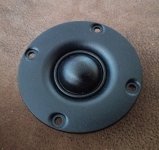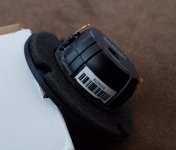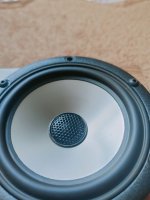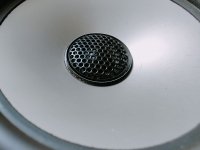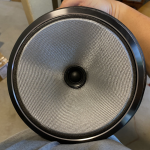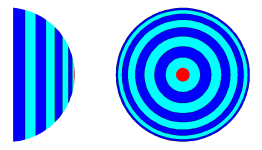@profiguy Thanks for the details, I do appreciate it! Do you sell your modified driver (you mentioned doing a few) or just did it for fun? I don't know if it would be that popular, but since I've come this far I think I may as well offer it to others as a little kit. I got some perfectly sized copper tube to duplicate the voice coil cap, too. Although I did a test with and without it, using a dummy plastic tweeter to fill the VC gap:


I saw a peak of 102 dB at just one point in the track, the rest was peaking around 98 dB @ 1 m from the right speaker.
Your meter is showing peak of 102 dB and average of 91 dB (or 92?). This difference would typically be 20 dB in high quality music recordings (18 for some recordings of your track) and for some sounds like internal combustion engines it can be 40 dB. If you sit 4m away and want to preserve the transients in the direct sound (reflections bring up the average) that is a further 12 dB of overhead.
It's an interesting subject because getting the average level loud enough is straightforward but compressing the odd peak in the recording/speaker/microphone/... is not always obvious. How much overhead is sufficient?
My rule of thumb is 115 dB for high fidelity (20 dB peak/average - 12dB distance => 83 dB average). Drop that by 5 dB and we don't lose much. Indeed for some modern music recordings nothing would be lost. Listening at 75 dB average is not unreasonable which is another 8 dB off and we are down to our 102 dB peak. It's not an implausible level but I would suggest it has possibly dropped below what is comfortably high fidelity/high quality reproduction in normal use in the home.
@Tenson The driver mod is still in development, mainly regarding the required manipulation of the tweeter to make it fit. The SB26STCN is the likely best performing tweeter for its size. Most smaller tweeters are too flimsy to keep up with the MR18. The stock tweeter isn't so bad if its crossed a little higher, but still not able to match the cone in dynamic capability as you already found out. The goal is a 2.3k electrical 3rd order xover. That allows for about 100W system power for the entire FR of the coax. The tweeter is pretty tough for its siize and the lack of ferrofluid. Not many 93dB /"2.83V compact tweeters around with 1mm P-P xmax.
This is what you're dealing with. The terminals have a soluable adhesive on them which can be removed with MEK or Acetone. The ribs on the chamber also need to be flattened and smoothed. The body is just under 38mm.
Attachments
I agree the dynamic range with a 2.3 KHz xover is probably less than ideal in this case. 3 KHz would be more reasonable.Your meter is showing peak of 102 dB and average of 91 dB (or 92?). This difference would typically be 20 dB in high quality music recordings (18 for some recordings of your track) and for some sounds like internal combustion engines it can be 40 dB. If you sit 4m away and want to preserve the transients in the direct sound (reflections bring up the average) that is a further 12 dB of overhead.
It's an interesting subject because getting the average level loud enough is straightforward but compressing the odd peak in the recording/speaker/microphone/... is not always obvious. How much overhead is sufficient?
My rule of thumb is 115 dB for high fidelity (20 dB peak/average - 12dB distance => 83 dB average). Drop that by 5 dB and we don't lose much. Indeed for some modern music recordings nothing would be lost. Listening at 75 dB average is not unreasonable which is another 8 dB off and we are down to our 102 dB peak. It's not an implausible level but I would suggest it has possibly dropped below what is comfortably high fidelity/high quality reproduction in normal use in the home.
We need real in-room measurments to assert what range is needed, because we don't get a loss of -6 dB from a doubling of distance in-room and we have two speakers.
IMO 115 dB is a nice target to know dynamic range is a non-issue, but not a requirement if other things suffer as a result.
Will not a 3rd order xover waste power in the xover region due to being out of phase with the woofer?@Tenson The driver mod is still in development, mainly regarding the required manipulation of the tweeter to make it fit. The SB26STCN is the likely best performing tweeter for its size. Most smaller tweeters are too flimsy to keep up with the MR18. The stock tweeter isn't so bad if its crossed a little higher, but still not able to match the cone in dynamic capability as you already found out. The goal is a 2.3k electrical 3rd order xover. That allows for about 100W system power for the entire FR of the coax. The tweeter is pretty tough for its siize and the lack of ferrofluid. Not many 93dB /"2.83V compact tweeters around with 1mm P-P xmax.
Edit: Or are you going DSP so you can seperate the filter points to be -6 dB and use delay to align the phase at xover?
Last edited:
It wouldn't specifically waste anything, except for sum more evenly with the midbass when accounting for the rising response of the tweeter with WG support. That allows the tweeter to come in at close to a 2nd order slope when HPed 3rd order in the curve where FR is still rising at 6 dB / Oct. Does that make sense?
Just to put dynamic range into perspective, using the peak reading as available inI agree the dynamic range with a 2.3 KHz xover is probably less than ideal in this case. 3 KHz would be more reasonable.
IMO 115 dB is a nice target to know dynamic range is a non-issue, but not a requirement if other things suffer as a result.
https://www.roomeqwizard.com/
one can see the RTA screen of snapping the thumb and middle finger
reads highest in the 2.5 to 3.5kHz range, the LZ Slow max reading around 79dB, the peak reading ~118dB.
Anyway, if a speaker can't reproduce finger snaps at a realistic level, I'd say it's on the timid side of dynamic range 😉
I don't want to get off topic, so I'll only add that using music you actually listen to is the test that really matters.
Seas recommended frequency range for the woofer is 200-2200 Hz.How high does the woofer go?
The woofer goes past 7kHz, but it's response is very peaky above 2.2 kHz.
The frequency and polar response of the woofer is worse above 2.2kHz than its tweeter, which Tenson chose to replace.
The woofer polar is narrower the higher you go, but not 'worse'. The important thing would be having a match between the woofer and tweeter at xover.
Something intersting is that I took the surround off my woofer to play around and glued it back on later. This somehow seems to have improved it! The spiky response is significantly reduced but distortion remains good. Dunno how I did that lol, maybe the contact adhesive and probably not reproducible.
Something intersting is that I took the surround off my woofer to play around and glued it back on later. This somehow seems to have improved it! The spiky response is significantly reduced but distortion remains good. Dunno how I did that lol, maybe the contact adhesive and probably not reproducible.
Last edited:
Another of my hair brain schemes was removing the plastic phase plug from a L12 and turn one out of copper. More for aesthetics than anything.
In the meantime I just offered the SB14 into the gap. Nice fit. The VC former of the L12 does protrude ever so slightly and I wouldn't dare tackle modifying it !
In the meantime I just offered the SB14 into the gap. Nice fit. The VC former of the L12 does protrude ever so slightly and I wouldn't dare tackle modifying it !
Attachments
So here is my question – If you are in to coaxials, would you be interested in this tweeter upgrade as a product? I was thinking about selling the modified tweeter and waveguide piece as a plug and play kit for the Seas MR18REX/RF. It would probably be about $50/piece.
YES!
Have you gotten any further with this?
Funny that I have missed this thread... I made a 3-way active project with MR18 coaxials in 2018 https://www.diyaudio.com/community/threads/seas-mr18-3-way.322839/
I also have three passive T18 coaxial 2-ways as HT mains (AW-7).
I accidentally broke one original textile tweeter and purchased alu versions that were on sale (used on T18) The problem wiat SEAS coaxials is poor fitting of the tweeter, making response wicked above 8kHz. Still power response is ok and at least I can't hear problems.
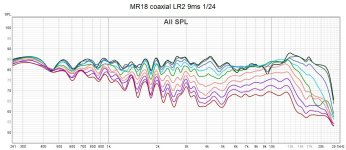
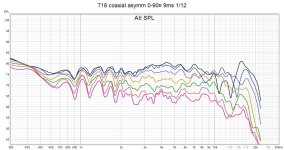
I also have three passive T18 coaxial 2-ways as HT mains (AW-7).
I accidentally broke one original textile tweeter and purchased alu versions that were on sale (used on T18) The problem wiat SEAS coaxials is poor fitting of the tweeter, making response wicked above 8kHz. Still power response is ok and at least I can't hear problems.


- Home
- Loudspeakers
- Multi-Way
- Do You Like My Coaxial?
